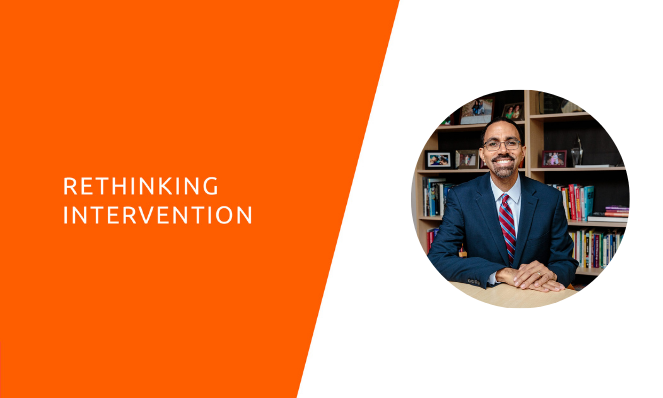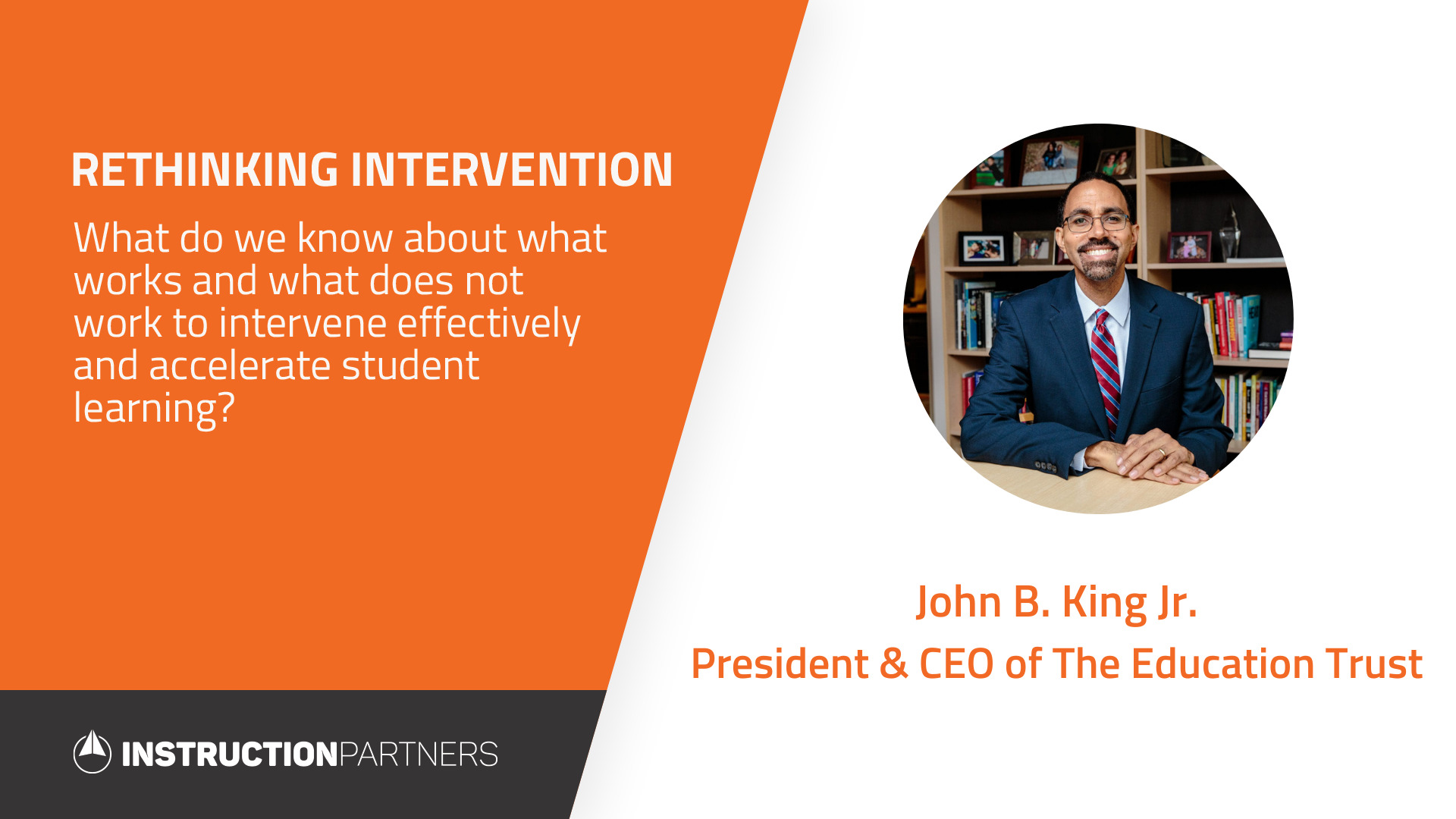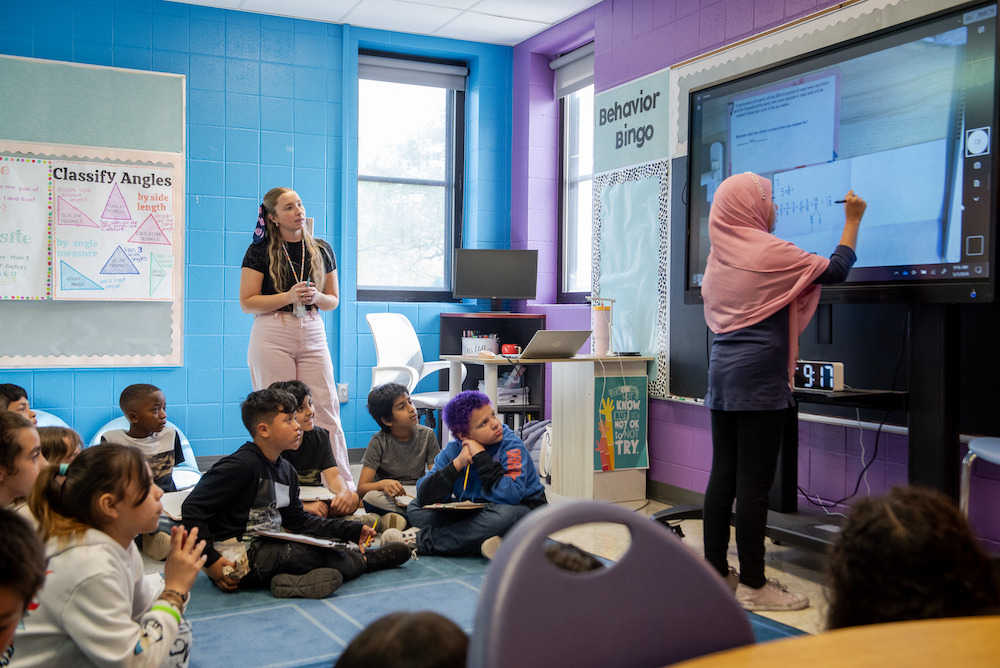
John King, The Education Trust
John King spoke to Emily Freitag about effective practices to accelerate student learning and the importance of centering solutions in equity. John King is the president and CEO of The Education Trust, a national nonprofit organization that seeks to identify and close opportunity and achievement gaps. He previously served in President Barack Obama’s cabinet as the 10th U.S. Secretary of Education.
Watch the full conversation or read the abridged Q&A below.

EF: Please tell us about your learning journey and how that informs you as you think about what it takes to accelerate learning for students.
JK: I began my education in New York City where I grew up. Both my parents were New York City public school teachers.
When I was eight in October of fourth grade, my mom passed away. And after that, I lived with my dad. My dad was quite sick with undiagnosed Alzheimer’s. So home was this place that was scary and inconsistent and unstable. But school was amazing. I had a teacher in fourth, fifth, and sixth grade, Mr. Osterweil, who saved my life. His classroom was safe and nurturing and supportive. And it was also incredibly academically rigorous and engaging. We read the New York Times every day—this was fourth, fifth, sixth grade— and we did productions of Midsummer Night’s Dream—Shakespeare in elementary school. We were exposed to a whole world beyond Canarsie, Brooklyn.
Those experiences at PS 276 shaped my life profoundly and also how I think about school. I really became a teacher because of the difference that Mr. Osterweil made in my life during a really difficult period.
And after I left his classroom, my dad was quite sick at that point and my dad passed when I was 12. I ended up moving around to different family members and different schools, but it was always teachers that gave me a sense of hope and purpose. But it also wasn’t a straight line. I always say to folks that I’m the first US Secretary of Education to have been kicked out of high school. Like many kids who experience trauma at an early age, I was really angry as a teenager. After I got kicked out, it was teachers and a school counselor who gave me a second chance, who were willing to see me as more than the sum of my mistakes. It has shaped how I think about the centrality of relationships to school and giving students a sense of purpose and hope when they may not have that on their own.
EF: You’ve had so many different experiences in education at every single level of our system. From your experience, what matters in the work of accelerating student learning? What works?
JK: The core of education in my mind is the relationship between the teacher and the students and the work in which they’re engaged. And so, the preparation of teachers and their training and their success in building relationships with students is foundational.
We know from the evidence that there is a science to teaching reading, so we should see that reflected in the curriculum. We know from evidence that students are going to be more successful in college and careers if they have a lot of opportunities to write throughout their educational experience, so we should have students writing. We know that students will need skills around research, so we ought to develop that in our curriculum. In many ways, the quality of the curriculum and the quality of the assignments is something we know a lot about. And yet in many places, we are not able to execute at the level that we should. But if we get the relationship right and the curriculum right, we’re off to a great start.
We have good evidence around the power of accelerating learning, giving students access to advanced coursework, and making sure that the work that they’re doing is pushing their academic skills forward. As opposed to dropping down the rigor level as soon as you see someone is struggling, what we should be doing is providing challenging work with support.
We have a lot of evidence that strong teachers and strong principals matter, but less evidence around what good teacher development and principal development looks like. That’s a real weakness in our field, and a place where we need to do a lot more evidence building.
EF: Can you give specific examples of practices we know do not work?
JK: I’ll give two examples. Some folks philosophically are unwilling to incorporate the teaching of phonics into reading instruction. The science is quite clear on this—if you do not do systematic phonics instruction within a reading program, not as the whole reading program, but within the reading program, you are going to have students who never learn to code. Some students will do it on their own, but many will not. Think about the great work that Emily Hanford has done in gathering the immense research evidence on this point. We know a good reading instruction program for the early grades is going to include systematic phonics instruction alongside a lot of exposure to reading, building fluency, hearing text read aloud, and building vocabulary.
And we also know that knowledge-building is critical to success in reading. We know that if students don’t learn science and social studies, they don’t build their vocabulary. If they aren’t exposed to the world around them, then they may be able to decode the words, but they won’t be able to make meaning of them. And so we’ve got to do systematic content knowledge building. To the extent that schools abandon science and social studies in favor of more drills that look like the state tests, they are making a pedagogical mistake. Students need content knowledge building if they’re going to be strong readers.
EF: We’ve been exploring the metaphors and mental models that we use as educators to think about how to address unfinished learning. Many seem to hinge on the idea of the sequential nature of learning. Are there models that you think would work better, as we think about the task of supporting students who will have missed a great deal of time in school?
JK: Well, this is one of the reasons that I think time for careful planning is going to be so critical for next school year. There is a danger in the sequential model that students never get exposed to grade-level work because you are in a downward spiral—you keep trying to go lower to provide something that students will be able to master, and then they’re not exposed to the kind of content that will actually push their learning forward. There is a danger to the sequential model, but there is also a danger to behaving as though those gaps that students have don’t matter and that you can get them to succeed with grade-level work without ever addressing those gaps. And so there’s this balance that is needed.
Think about what we’re learning in higher ed space around corequisite courses. Remedial courses send a signal to entering freshman that college is not for them. Remedial courses are often ineffective, they don’t help students get credits that get them closer to graduation, and they’re expensive for students. Remediation hasn’t worked, yet just placing a student in a course where they’re unprepared is also unlikely to work. A good corequisite strategy where students are engaging in credit-bearing coursework, but also getting additional support such as tutoring and small group work, and where the curriculum is intentionally designed to cover and address some of the gaps they may have—that has a lot of promise. And I think there are some lessons there for K–12 as we think about how we make up for this incredible learning loss we’re going to see from COVID-19.
EF: How do we operate with a mindset of commitment to true equity as we plan for the next couple of years?
JK: We have to start by figuring out what is needed by the students who are most vulnerable. If we address their needs, then the students who are affluent with a lot of privilege are going to be fine. But instead, what we do in many places is start with a student who has very few obstacles. And then someone in the meeting has to say, “Oh, but what about English learners? What about students with disabilities? What about kids who don’t have internet access?” And then we end up backing into our strategies to address equity rather than putting equity at the center.
We need equity at the center. Over the next few months, we have got to close the digital divide, we have to make sure that all kids have devices and internet access.
And then, after the devices, we have to make sure that learning is really engaging, interesting, and compelling. Saying “Hey, here’s, here’s how you get logged into Zoom” is not enough. We need engaging online instruction that takes advantage of education technology tools to make learning compelling.
Just like regular in-person class, you have got to make it good. Kids have to feel like they’re learning. There are opportunities to build in video, to build in hands-on projects, the asynchronous delivery of some content with synchronous interaction, supporting students’ work on projects or discussing the text. We have to figure that out for this period, but given the evolution of the pandemic, this is likely for periods next school year as well, so we have got to get it right.
We need to figure out a strategy to get students the support they need to close learning loss gaps and we have got to have a strategy around socio-emotional and mental health support. Some kids are home with two parents who are teleworking—it’s challenging, they’re juggling a lot, but they’re able to support their kids’ learning. Other kids are in homes where maybe the parents aren’t home. Only 20% of the African American workforce can work from home. Or maybe they’re in a home where there’s domestic violence, or addiction, or abuse. And so this missed period of school is compounding their trauma and their stress and we need to address that when kids come back.
EF: That’s a sobering view of just how much we have to get right all at the same time. Thank you so much for spending some time with us and we look forward to continuing to learn from all the work you all are doing at EdTrust.
JK: Thank you and thanks for what you’re doing to Instruction Partners to get in there side-by-side with districts, with principals, and with teachers to figure out how to advance equity.


